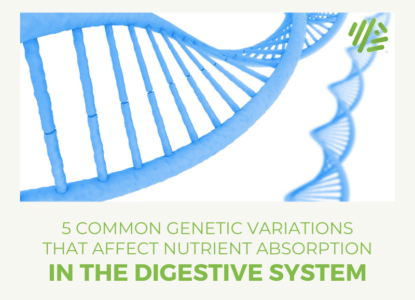Diet and Migraines: Why Risk Goes Beyond Common Trigger Foods
Article at a Glance
- Migraines can be a chronic condition for many people, most often women. Migraines are a central nervous system disorder characterized by a piercing headache, and our diets, lifestyle, environment, and genetics may all play a role in the severity of migraines.
- Low serotonin levels also can trigger migraines, with ovarian hormones in women affecting serotonin.
- A variety of genetic mutations may increase our risk for migraines, including CACNA1A, ATP1A2, SCNA1A, MTHFR, KCNK18, HCRTR1, SLC6A4, STX1A, GRIA1, and GRIA3. In one study, when people with MTHFR mutations who had migraines supplemented with folate and vitamins B6 and B12, their homocysteine levels decreased along with their migraine pain.
- Food choices are also a big factor in migraines, with common foods and beverages linked to migraines including dairy products, alcohol, tea and coffee, chocolate, processed meats, citrus fruits, and beans. Some of the substances in these food items may particularly trigger migraines in people with a susceptibility to them, such as caffeine in coffee.
- Finally, too much histamine and elevated lactic acid levels may trigger migraines. Avoiding foods that inhibit DAO production may help with histamine clearance, while supplementing with nutrients responsible for mitochondrial metabolism (magnesium, PQQ, etc.) and avoiding sulfites can address energy metabolism issues related to migraines.
Genes Mentioned

Contents
Like many people, I grew up with a parent who suffered from debilitating migraines. I learned early on the importance of keeping noise, lights, stress, and smells to a minimum on a migraine day, despite not suffering from migraines myself.
Migraine is a central nervous system disorder characterized by a severe, piercing headache, usually focused around the eye and in the temples. It typically affects just one side of the head at a time. Researchers haven’t found any evidence linking migraines to damage in the brain, however, leaving diet, genes, and environmental factors center stage as potential migraine triggers.
Who gets migraines?
- Around 11-15% of the population suffers with migraines and most migraineurs are women. 1 2 Indeed, migraines are most prevalent in women between the ages of 25 and 45. Overall, women are three times more likely than men to experience migraines. 1 2
- Migraines also tend to run in families.
- If you have a first-degree relative who suffers from migraines, you are almost twice as likely as average to experience migraines yourself. This certainly suggests a genetic component to the disease.
- Interestingly, many of the genetic mutations linked to an increased risk of migraine appear to be related to how your body handles certain nutrients. Looking to your genotype could, therefore, offer clues as to how to help prevent migraines or reduce symptom severity.
If you need help getting started, Aaron wrote an excellent post on the types of DNA tests out there and how to choose one that works for you: Finding the best DNA test: Should I genotype or sequence? After you receive your results, this blog, along with our Genetics and Nutrition Guide, are excellent resources to keep handy during the next steps of your health-improvement journey.
So, if genetics influence your risk of migraines, and this is linked to nutrition, what does this mean for migraines and diet?
Why are diet and migraines linked?
There is considerable evidence linking migraines and genetics via our food choices. 2 Indeed, several common foods, food additives, and beverages appear to be a migraine trigger in people with a genetic susceptibility to migraines.
- Many foods and drinks are linked to migraines, including cheese, red wine, bananas and chocolate.3 This may be because certain foods trigger an immune system response similar to an allergic reaction in some people.
- Given that every individual is different, there’s no one-size-fits-all when it comes to a migraine-free diet. Indeed, it may do more harm than good for most people to adopt a strict elimination diet that cuts out a whole boatload of foods. Without careful planning, elimination diets can cause nutrient deficiencies that actually increase the risk of migraine.
- That said, targeted dietary restriction, based on IgG testing, has been seen in at least one study to help reduce the frequency and severity of migraine attacks.4
- Current thinking on migraines suggests that certain substances in the foods and drinks mentioned above may cause blood vessels to constrict or expand in a dysfunctional way, triggering migraines in those with a genetic susceptibility. 5 Other research suggests that compounds in foods may also cause migraines through direct stimulation of the trigeminal ganglia, brainstem, and cortical neuronal pathways. 6
I’ve already mentioned a few frequently reported dietary triggers for migraines, but let’s look now at 7 foods commonly linked to migraines and what you can do about them.
Migraine headaches and diet – 7 common migraine triggers
1. Alcohol, especially red wine!
Alcohol of any kind can lead to dehydration, a known trigger for headaches. It’s no surprise, then, that many migraineurs make the link between migraine attacks and alcohol consumption. Alcohol may also trigger migraines and headaches in other ways though. For instance, alcohol can directly interfere with histamine clearance and may lead to depleted levels of some nutrients needed for a healthy immune response.
Many alcoholic also contain the food preservative sulfite, which can trigger migraines. Sulfite impairs the Krebs cycle and can reduce production of the body’s main form of energy – adenosine triphosphate (ATP) – by 50%. The brain is especially hungry for energy, and neurons are particularly vulnerable to a disruption in the Krebs energy cycle.7 As such, migraineurs may be wise, for many reasons, to avoid alcohol, especially alcohol that contains sulfites.
In one study, looking at 577 patients attending a migraine clinic:8
- 18.4% reported sensitivity to all alcoholic drinks
- 11.8% were sensitive to red wine (but not to white wine)
- 28% were sensitive to beer.
Now, here’s the really interesting bit: those patients who were sensitive to red wine and/or beer were more likely to also be sensitive to cheese and chocolate. This strongly suggests that there’s a shared mechanism linking these foods to migraines.
2. Chocolate
In a comprehensive study looking at food and migraines, 16.5% of migraineurs reported being sensitive to cheese or chocolate, and nearly always both. Why might this be? The most likely culprit is tyramine, a substance produced by bacteria when they break down tyrosine. 9
Tyramine is also found in wine, yeast extract, cheese, and processed meat products, and levels of tyramine have been seen to be higher in chronic migraineurs than in those with other types of headache disorders or who are healthy.10
3. Cheese, milk and other dairy products
Remember what we said about histamine and allergies being linked to migraines? Well, guess which foods are a common trigger for an immune system reaction. Yep, dairy.
If you’ve had your genome run, you probably already know if you’re lactose intolerant. If you are, eating dairy products could well play a role in triggering migraines (and other unpleasant symptoms).
Even if you’re not lactose intolerant, though, cheese, milk, and other dairy products could still be a cause of your migraines. This might be because some cheese (especially aged cheese) is incredibly high in tyramine (which has been linked to migraines). Indeed, some 9-18% of migraineurs report sensitivity to aged cheese in particular.9
Many types of cheese also contain histamine, which has been linked to migraines.11 Frustratingly, what doesn’t trigger a migraine one day may quickly trigger a migraine on any other given day. This is thought to be due, in part, to something called histamine load. Put simply, if your histamine levels are already high because of your environment, eating a food high in histamine may trigger symptoms. If your histamine load is low, you might not notice any effect from eating that food.
(If you suspect that histamine might be contributing to your migraines, you’ll want to read this post by John: Welcome to Austin, now lay off the sauerkraut.)
4. Citrus fruits and bananas
Citrus fruits were reported to be a trigger for migraines in about 11% of people in one study.9 The same study found that there wasn’t much crossover between citrus fruits and chocolate in migraineurs, though, unlike with chocolate, cheese, and alcohol. This suggests a different mechanism by which citrus triggers migraines. Unfortunately, researchers haven’t figured out this mechanism as yet.
One theory is that while citrus fruits don’t contain much histamine themselves, they may be ‘histamine liberators’. This means that they can prompt your body’s cells to release histamine. This remains a theory, though, with no clear supporting evidence.
Just as with citrus, bananas may be so-called ‘histamine liberators’. Again, there’s no good evidence to back this up.
What does that mean for you? Well, you may want to start keeping a food and symptom diary. This can help you figure out if your migraines are linked to citrus fruits or bananas. If that’s the case, consider following a three week elimination diet where you don’t eat bananas or citrus (or have citrus fruit juices). Then, reintroduce the foods one at a time and see what happens.
5. Pork and cured or processed meats (such as hot dogs)
If the term ‘hot dog headache’ means nothing to you, you’re lucky. Around 5% of migraineurs report having migraine attacks just minutes or hours after eating processed meat products, such as hot dogs, salami, bologna, sausages, and cured ham and bacon.12
The most likely explanation for this is that these meats contain our old pal tyramine as well as histamine and nitrites. Nitrites are a group of preservatives often found in processed meat products. They include potassium nitrite and sodium nitrite, which help preserve the color of cured meats and prevent the growth of the bacterium that causes botulism (Clostridium botulinum).13
So, if you get migraines and are looking for another reason to cut out processed meats, there you go!
6. Tea, coffee, and caffeinated soda
If you’re a regular coffee drinker (or tea drinker!), you’ll probably know that going cold turkey can be rough. Withdrawal headaches are common, especially if you drink several cups of coffee a day. Caffeine withdrawal is no joke and can lead to headaches, migraines, nausea, poor concentration, and a sharp dip in mood.
Around half of all regular coffee drinkers experience headache after 12-24 hours without coffee, and 13% experience functional impairment in one study.14 Those with headaches had gradually worsening symptoms that peaked at around a day to two days of abstinence. In some people, a caffeine withdrawal headache lasted 2-9 days!
If you’re going to cut out caffeine, then, do it slowly. This gives your body time to adjust and will keep withdrawal symptoms to a minimum.
Caffeine’s relationship to migraines is more complicated than just being a trigger when you cut it out. Drinking a cup of coffee at the first sign of a headache may actually help prevent the migraine from developing fully, especially if combined with aspirin and Tylenol. In one protocol, a combination of acetaminophen 500 mg, aspirin 500 mg, and caffeine 130 mg (taken at the first sign of a migraine) was more effective at preventing migraine than a product marketed for migraine relief.15 Another study found that aspirin and paracetamol were far better at preventing a full-blown migraine when taken in combination with caffeine.16
That said, a high intake of caffeine can also trigger migraines in some people. For instance, excessive caffeine intake from soda is a key migraine trigger in children and teenagers. Many kids (and parents) don’t realize just how much caffeine is in a lot of soft drinks, nor how many of these drinks kids are consuming. In one study, almost every child migraineur had a complete resolution of migraines once they weaned themselves off caffeinated soda.17
Your best bet? Keep you caffeine intake low and/or regular. If you foresee a need to cut it out, cut it down first.
7. Artificially sweetened drinks
Aspartame has long been linked to migraines. This artificial sweetener is frequently found in zero calories sodas and may be a key factor in migraine in children. Unfortunately, the few studies that have looked at aspartame and migraines have failed to find a consistent link between the two.1819 Still, given that aspartame has neurotoxic effects and can affect the normal synthesis of important neurotransmitters, I wouldn’t be all that surprised if drinking artificially sweetened drinks triggers migraines in some people.
A handful of case reports also detail a link between migraines and sucralose, another artificial sweetener (sold as Splenda).2021 Again, though, there’s been little clinical study on the link between sucralose and migraine. As such, your best bet is to keep a food and symptom diary and note any association between the two.
Other foods to watch out for if you’re a migraineur
If you’ve been diligently keeping a food diary and can’t figure out any consistent link between any given food and your migraines, you may be dealing with a histamine load issue. As I mentioned earlier, the histamine load theory can explain why you might react to a food one day and have no symptoms the next time you eat it.
If this sounds familiar, you may want to look at keeping your overall consumption of histamine foods low. This means taking note of your intake of the following foods:
- Fermented dairy products, such as kefir, aged cheese, yogurt, sour cream, and buttermilk
- Sauerkraut, kimchi, and other fermented vegetables
- Pickles
- Kombucha
- Cured or fermented meats
- Alcohol!
- Tempeh, miso, soy sauce, and natto
- Sourdough bread and other fermented grain products
- Vinegar
- Tomato ketchup.
Some veggies are also naturally high in histamine, including
- tomatoes
- eggplant
- spinach.
And, finally, keep an eye on your consumption of frozen, salted, or canned fish. Sardines and tuna, for instance, can also be high in histamine.
Final thoughts on diet and migraines
In addition to the interaction between genetics, diet, and migraines, migraineurs may also be suffering because of metabolic dysfunction. Migraineurs have been found to have elevated lactic acid levels in blood and cerebrospinal fluid, for instance, and lactic acidosis is characteristic of mitochondrial dysfunction.22
While the research is preliminary, there is some suggestion that migraineurs may benefit from boosting levels of nutritional cofactors for mitochondrial metabolism. Such nutrients include coenzyme Q10, PQQ, magnesium, and B vitamins, as well as fatty acids and phospholipids.2324
And, finally, hypoglycemia is another migraine trigger, meaning that migraineurs would do well to avoid fasting or skipping meals.


